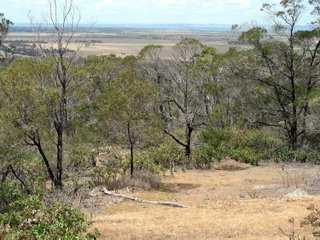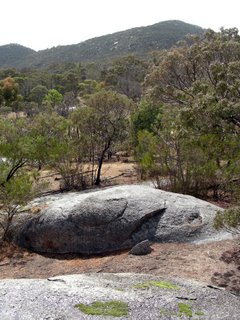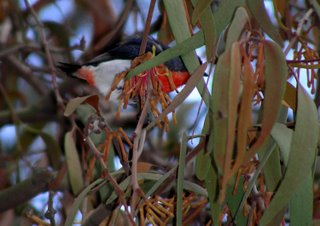 A friend and I spent the day at the You Yangs and Serendip Sanctuary. I just dropped her off at the airport and now I'm sorting through 240 photographs of our big day out. There would have been more but my camera batteries went flat. (Memo to self: carry a spare set, you idiot.) They went flat just as five (count 'em) whistling kites joined a bunch of pelicans soaring on a thermal over Serendip. They remained flat when one of the kites decided to grab a grey teal duckling from a sand bank. (It missed.) And when the only grebe of the day—a hoary-headed—disported itself with ungrebe-like candour on the lake right in front of me. But they managed to gather together enough residual charge to produce two images of a parasitised sawfly larva. Go figure.
A friend and I spent the day at the You Yangs and Serendip Sanctuary. I just dropped her off at the airport and now I'm sorting through 240 photographs of our big day out. There would have been more but my camera batteries went flat. (Memo to self: carry a spare set, you idiot.) They went flat just as five (count 'em) whistling kites joined a bunch of pelicans soaring on a thermal over Serendip. They remained flat when one of the kites decided to grab a grey teal duckling from a sand bank. (It missed.) And when the only grebe of the day—a hoary-headed—disported itself with ungrebe-like candour on the lake right in front of me. But they managed to gather together enough residual charge to produce two images of a parasitised sawfly larva. Go figure. The You Yangs are about 55 km SW of Melbourne. The granite ridges rise 300 m and more above the basalt of the Werribee Plain. Although the surrounding landscape was sculpted by volcanic activity during the past 4 million years, the You Yangs were formed from a much older intrusion of magma into the overlying sedimentary rocks. Weathering eroded those rocks and exposed the granite. The hills are the most obvious geological feature between Melbourne and Geelong.
The You Yangs are about 55 km SW of Melbourne. The granite ridges rise 300 m and more above the basalt of the Werribee Plain. Although the surrounding landscape was sculpted by volcanic activity during the past 4 million years, the You Yangs were formed from a much older intrusion of magma into the overlying sedimentary rocks. Weathering eroded those rocks and exposed the granite. The hills are the most obvious geological feature between Melbourne and Geelong. Humans influence has been strong. The Yawangi balug ground out wells in the granite to improve the water supply. European settlers harvested timber and excavated gravel. Part of the park is timber plantation, the neat rows of gum trees devoid of understorey contrasting with the tangled and tatty natural bush.
Humans influence has been strong. The Yawangi balug ground out wells in the granite to improve the water supply. European settlers harvested timber and excavated gravel. Part of the park is timber plantation, the neat rows of gum trees devoid of understorey contrasting with the tangled and tatty natural bush.We didn't climb Flinders Peak (which was scaled by Matthew Flinders on 1 May 1802). I would have, you know, if it hadn't been raining. (Oh, come on. Would I lie to you?) Instead, we did the Big Rock walk, which took us past a plantation, through woodland where the cherry ballart (Exocarpos) was producing fruit and onto a massive outcrop of granite. Big Rock, I suspect.
 We saw—but failed to identify—a whole bunch of small, twittering, hyperactive birds. One of us couldn't focus the binoculars, the other couldn't get the camera sorted out quickly enough. (They were probably silvereyes.) But that changed on the way back. We stopped next to a stately gum and the birds came to us. First a grey fantail. Then an eastern yellow robin. Then a New Holland honeyeater mum feeding its fluff-ball chicks. And finally a mistletoe bird. The latter was sitting about 2 m above my head, so I almost got a decent picture of it. But not quite. I have low standards to maintain.
We saw—but failed to identify—a whole bunch of small, twittering, hyperactive birds. One of us couldn't focus the binoculars, the other couldn't get the camera sorted out quickly enough. (They were probably silvereyes.) But that changed on the way back. We stopped next to a stately gum and the birds came to us. First a grey fantail. Then an eastern yellow robin. Then a New Holland honeyeater mum feeding its fluff-ball chicks. And finally a mistletoe bird. The latter was sitting about 2 m above my head, so I almost got a decent picture of it. But not quite. I have low standards to maintain.